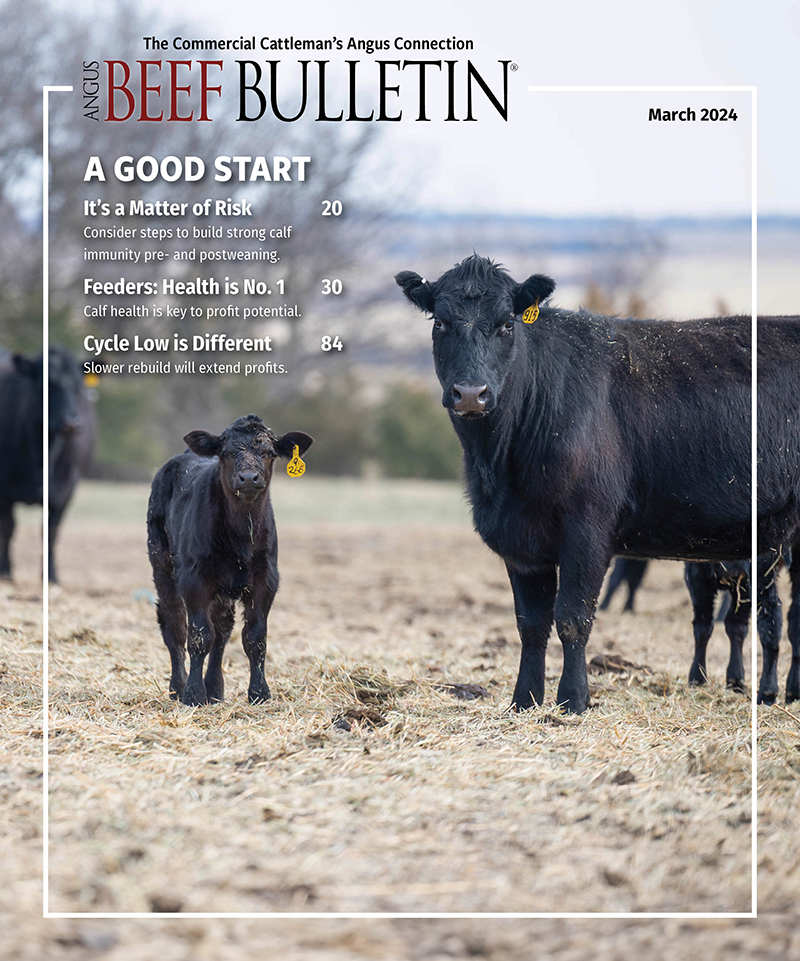
Selection of Replacement Heifers
Eight criteria to use for keeping the best heifers.
Low cow herd inventories, historically high calf prices, looking for the first hollow stem, breeding season just a month or two away, and the recent USDA Cattle Inventory report shows a tight supply of beef replacement heifers. This leads us to the topic of selection criteria for replacement heifers.
Selecting heifers that will have an optimum mature size and milk level to fit our production system, breed quickly, wean a calf annually and have longevity is important. What should we consider when selecting yearling heifers as replacements?
Early puberty
The younger a heifer begins to cycle, the better her chances are of conceiving in time to calve by 24 months of age. Early puberty is moderately to highly heritable and positively related to future reproductive efficiency. Reproductive tract scoring can be used to evaluate puberty status. Typically, reproductive tract scoring is done four to six weeks prior to the breeding season and serves as a tool to indicate reproductive readiness to conceive.
Fertility
Heritability estimates of fertility are extremely low. However, because reproduction is so economically important, it should be a priority in heifer selection. Realistic goals for heifers would be a 60%-70% first-service conception rate and a 90%-95% bred rate after a 60-65-day breeding season. Heifers should be held accountable and culled if they don’t meet these standards.
Keep in mind, early preg-checking of replacement heifers permits opens to be marketed at yearling prices. Over time, culling the heifers that don’t get pregnant in a defined breeding season will result in a cow herd with more fertility. Furthermore, heifers that calve in the first 21 days of the calving season have increased longevity and wean more pounds of calves during their lifetime. Keeping 5%-10% more heifers than needed for breeding permits you to cull the subfertile heifers and maintain adequate replacement heifer inventory moving forward.
Milking ability
Research clearly indicates the optimum level of milk production in a beef herd is relative to the forage/feed resources available in their production environment. Milking ability is low in heritability. The most effective means of selecting for an optimum milk level is through the use of milk expected progeny differences (EPDs) on the sire.
Keeping heifers from heavy-milking cows comes with the risk of heifers getting overly fat prior to weaning. When this happens, the heifers’ subsequent milk production may suffer due to fat deposits in the developing mammary system.
The mammary system
While difficult to assess the mammary system of virgin heifers, it is important to avoid heifers with teats that are barely visible and appear embedded in hair or fatty tissue. When possible, consider the udder and teat structure of the dam who produced the heifer.
Disposition
Disposition is reported to be moderate to highly heritable. Culling heifers with bad dispositions will improve the ease of herd management, producer safety and conception rates.
Body type/fleshing ability/muscle thickness/structural soundness
Heifers that are easy fleshing typically are structurally sound, have a wider structural frame and a body type of more rib shape and depth. Heifers with this body type will be heavier muscled. Evaluating replacement heifers for structural soundness should include the evaluation of feet, legs and eyes as soundness contributes to longevity in production. Fleshing ease equates to breeding females that better maintain body condition and energy reserves on a given amount of feed.
Growth rate
Heifers with good growth rate and of moderate frame size should make the best cows. Those that are extremely light, extremely heavy or too large-framed at a given age should be culled. Commercial cow-calf producers sell pay weight, and replacement heifers with more growth should transmit this advantage. That being stated, much like milk, there is an optimum mature cow size relative to the production environment. Keep in mind, puberty is a function of age and weight. The target weight of yearling heifers is 65% of their mature size.
Calving ease
Measuring the pelvic area of yearling heifers and considering the calving ease maternal (CEM) EPD of the sire can be used as selection tools to reduce dystocia. Pelvic area is typically measured in square centimeters. As a general rule of thumb, dividing the yearling pelvic area by 2.1 indicates the size of calf [in pounds (lb.)] she should be able to deliver unassisted. For example: a yearling heifer with a pelvic area of 175 ÷ 2.1 = 83, indicating she should be able to deliver a calf of up to 83 lb. CEM EPDs predict the likelihood of a bull’s daughters delivering their first calf unassisted. For example: a heifer sired by a bull with a CEM of 15 is 11% more likely to calve unassisted than if sired by a bull with a CEM of 4.
Sire selection of the bulls to mate to virgin heifers is of paramount importance in reducing the incidence of dystocia. Calving-ease bulls will have lower birth weight (BW) and higher calving ease direct (CED) EPDs within their respective breed.
Final thoughts
Selecting the oldest heifers has long been considered an effective method of identifying replacements produced by the earliest calving cows. Heifers born late in the calving season or that are less than 13 months old at the onset of their first breeding season will be more challenged to breed quickly.
Editor’s note: Mark Johnson is an extension beef cattle breeding specialist for Oklahoma State University. [Lead photo by Shauna Hermel.]
References: www.iowabeefcenter.org/bch/ReplacementHeiferSelection.pdf
www.angus.org/Nce/SireEvaluation
https://jasbsci.biomedcentral.com/articles



